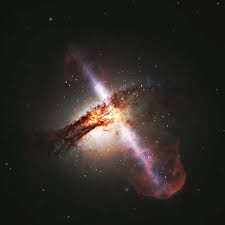Black holes and secret
A black hole is an area of spacetime where gravity is so powerful that nothing can escape it, including particles and electromagnetic waves like light. A sufficiently compact mass may bend spacetime to generate a black hole, according to general relativity theory. The event horizon is the point at which there is no way out. Although it has a huge impact on the fate and circumstances of an item passing through it, it has no locally discernible properties, according to general relativity. A black hole is similar to an ideal black body in that it does not reflect light. Furthermore, in curved spacetime, quantum field theory predicts that event horizons emit Hawking radiation, which has the same spectrum as a black body with a temperature that is inversely proportional to its mass. For black holes of stellar mass, this temperature is on the order of billionths of a kelvin, making direct observation very impossible.
A galaxy passes behind a Schwarzschild black hole on a plane perpendicular to the line of sight in this animated simulation. Extreme gravitational lensing of the galaxy by the black hole is detected around and during the time of precise alignment. Objects with gravitational fields that are too powerful for light to escape were initially studied by John Michell and Pierre-Simon Laplace in the 18th century. Karl Schwarzschild discovered the first contemporary solution of general relativity that would characterise a black hole in 1916, and David Finkelstein presented the first interpretation of it as a region of space from which nothing can escape in 1958. Black holes have long been regarded as a mathematical puzzle. Theoretical study in the 1960s revealed that they were a generic prediction of general relativity. Jocelyn Bell Burnell's discovery of neutron stars in 1967 piqued interest in gravitationally compressed compact objects as a possible astrophysical reality. Cygnus X-1 was the first known black hole, discovered in 1971 by various astronomers separately. Theoretical study in the 1960s revealed that they were a generic prediction of general relativity. Jocelyn Bell Burnell's discovery of neutron stars in 1967 piqued interest in gravitationally compressed compact objects as a possible astrophysical reality. Cygnus X-1 was the first known black hole, discovered in 1971 by various astronomers separately.
The interaction of a black hole with other stuff and electromagnetic waves such as visible light can be used to infer its presence. Quasars are among of the brightest objects in the cosmos, formed when matter falls upon a black hole and forms an exterior accretion disc heated by friction. Stars that travel too close to a supermassive black hole can be shredded into dazzling streamers before being "swallowed."The orbits of other stars around a black hole can be utilised to calculate the black hole's mass and location if there are any. These findings can be used to rule out other possibilities, such as neutron stars. In this approach, scientists have discovered a number of star black hole candidates in binary systems, as well as the presence of a supermassive black hole of roughly 4.3 million solar masses in the radio source known as Sagittarius A* in the centre of the Milky Way galaxy. The LIGO Scientific Collaboration and the Virgo Collaboration reported the first direct detection of gravitational waves on February 11, 2016, which was also the first observation of a black hole merger. As of December 2018, eleven gravitational wave occurrences originating from 10 merging black holes has been seen (along with one binary neutron star merger). Following studies of the supermassive black hole in Messier 87's galactic centre by the Event Horizon Telescope (EHT) in 2017, the first direct image of a black hole and its surroundings was published on 10 April 2019.
The EHT Collaboration published a polarized-based picture of the black hole for the first time in March 2021, which may help unveil the dynamics that give origin to quasars. The supermassive black hole in the centre of the supergiant elliptical galaxy Messier 87, with a mass of nearly 7 billion times that of the Sun, as seen in the first false-color image published by the Event Horizon Telescope in radio waves (10 April 2019). The crescent-shaped emission ring and centre shadow are gravitationally enlarged images of the black hole's photon ring and photon capture zone on its event horizon, respectively. The shadow is roughly 2.6 times the diameter of the event horizon and is formed by the black hole's spinning and relativistic beaming. The Milky Way's central black hole is ripping apart a gas cloud (observations from 2006, 2010 and 2013 are shown in blue, green and red, respectively). The closest known body considered to be a black hole is roughly 1500 light-years distant as of 2021. (see List of nearest black holes). Though just a few dozen black holes have been discovered so far in the Milky Way, hundreds of millions are expected to exist, the majority of which are solitary and do not emit radiation, making them only observable by gravitational lensing.
In a letter published in November 1784, English astronomy pioneer and priest John Michell suggested the notion of a planet so huge that even light could not escape. Michell's calculations assumed that such a body would have the same density as the Sun, and he determined that one would arise when a star's diameter surpasses the Sun's by a factor of 500, and its surface escape velocity exceeds the speed of light. These bodies were dubbed "black stars" by Michell. He was accurate in pointing out that non-radiating supermassive bodies may be detected by their gravitational impacts on neighbouring visible bodies.Scholars were initially enthralled by the prospect of giant but invisible 'dark stars' lurking in plain sight, but their enthusiasm was dampened when the wavelike nature of light was discovered in the early nineteenth century, because if light were a wave rather than a particle, it was unclear what, if any, effect gravity would have on escaping light waves.
'In and of itself, this book is a revolution.' The author has written the "truth" in a brilliantly eloquent manner. A must-have for everyone who has completed high school and want to pursue a career as an astronomer. This book is written by-ABHAS MITRA. Abhas Mitra is a former full member of the American Astronomical Society and a member of the International Astronomical Union. From 2005 until 2015, he was the head of the Bhabha Atomic Research Centre's Theoretical Astrophysics Section in Mumbai. He was awarded First Prize at the Indian Physical Society's Young Physicists Colloquium in 1989.
Michell's theory of a light ray shooting directly from the surface of a supermassive star, being slowed by the star's gravity, halting, and then free-falling back to the star's surface is disproved by modern physics. Albert Einstein formulated his theory of general relativity in 1915, after previously demonstrating that gravity did affect light's velocity. Karl Schwarzschild solved the Einstein field equations, which describe the gravitational field of a point mass and a spherical mass, only a few months later. A few months later, Johannes Droste, a Hendrik Lorentz student, independently gave the identical solution for the point mass and wrote more extensively on its features. This solution showed an odd behaviour at what is now known as the Schwarzschild radius, when it turned singular, implying that portions of the equations were no longer valid. At the time, the nature of this surface was not fully understood. Arthur Eddington demonstrated in 1924 that the singularity vanished when the coordinates were changed (see Eddington–Finkelstein coordinates), but it took Georges Lemaître until 1933 to recognise that this indicated the singularity at the Schwarzschild radius was a non-physical coordinate singularity. In a 1926 book, Arthur Eddington did mention the possibility of a star with mass compressed to the Schwarzschild radius, stating that Einstein's theory allows us to rule out excessively large densities for visible stars like Betelgeuse because "a star of 250 million km radius could not possibly have such a high density as the Sun."
1. Black holes used to be stars-
Stars live for a long period, yet they, like us, do not exist in perpetuity. They gradually deplete the fuel that allows them to shine. When they run out, one of three things happens, mostly dependent on how much of them there are (which is how much matter something contains). A white dwarf, a neutron star, or a black hole will develop from the star. If the star is large enough (say, 10 or 15 times the size and mass of the sun), it will explode when it approaches the end of its life cycle! The star collapses in on itself as a result of the explosion, shrinking significantly. The gravity surrounding the star grows so powerful that it absorbs everything around it, including light, as the size of the star shrinks but the mass of the star does not. And that's how black holes are formed.
2. There are 3 types of black holes-
Primordial: These are regarded as insignificant! They might be as little as a single atom or as large as a mountain. Mountains may not appear little to you, but space is a huge area!
Stellar: These are the ones that are most commonly found. They are around 20 times the size of the Sun!
Supermassive: This is the category in which the black hole found in 2015 belongs. To be included in this category, the hole must be over a million times the mass of the Sun!
3. Black hole helped create galaxies:
Astronomers aren't clear how important black holes were in the formation of galaxies. However, one idea suggests that a massive star burst, a black hole emerged, and the rest of the galaxy grew up around it!
Guys, I hope you've liked these strange things about black hole. Please let me know in the comments section below if you enjoyed this blog. We'll meet again in the future blog, but in the meanwhile, check out some of my past writings and remember to smile and enjoy your day!!
My past writings:Mystery of universe-- https://bustlingmindd.blogspot.com/2021/10/mystery-of-universe.html








